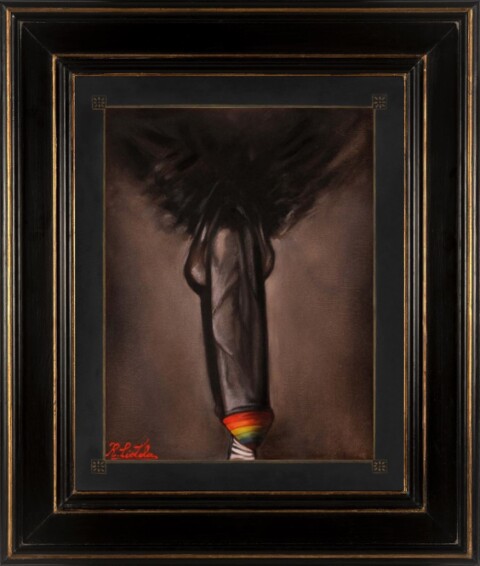"Art is a gift, not a business. Artists should not have to pay to make their creativity known. Just as musicians don't pay to be heard, painters and visual artists deserve to be seen without facing additional costs. Their art is a treasure for everyone, and the world should be able to appreciate it without economic barriers. The visibility of artists should be natural, just like their talent."
ART AGAINST HOMOPHOBIA''THE BLACK PHALLUS''
Work of art by Maestro Raffaele Ciotola

The vision of this pictorial work immediately leads to ascertaining its singularity and apparent provocation, if it is not included in the ''Stop Homoph Art'' artistic current.
In fact, a pornographic implication is to be excluded, as it is a representation that clearly refers to the homosexual issue due to the presence of the colors of the GLBT flag.
Generally, representations centered on male sexuality were in the recent past considered obscene and even today they can arouse discomfort or annoyance even to the most tolerant and less puritanical people.
But, in fact, it would be enough to think of how numerous and commonly spread the representations of the male member were in ancient art, from Egyptian to Greek and Roman art, which did not necessarily have an erotic or sexual reference, but could very often express a idea of fertility and fecundity.
For example, the iconography of the god Dionysus with his orgiastic procession and ithyphallic representations not only alluded to virility and strength, but could also have apotropaic purposes.
In this case, the artist has portrayed a penis, of considerable size, relaxed and milky, with the scrotal sac in an upper position, on a completely black background, to indicate with this chromatic neutrality that the message resides in the colors of the Rainbow Flag.
The prominent and polychrome end almost seems to indicate and trace a track, a new road towards an open and tolerant society.
This work by R. Ciotola, more than any other, surprising us, manages to shake us from our torpor, "stings" our sensitivity through the uncanny impact with reality.
All of this takes place in a dimension of symbolic mediation, which shuns an aesthetic of repulsion, avoiding the apology of the ugly or disgusting, and which has the sole purpose of externalizing and reaffirming the values of freedom and respect.
Prof. Michela Marconi
ART AGAINST HOMOPHOBIA
" STOP HOMOPH ART "
The Movement was founded in 2003, Italy by Raffaele Ciotola.
The scope of the movement is to discourage racist attitudes and homophobic behaviour that arise when a glbt homosexual work of art is exhibited to the public. The idea is to spread cultural awareness and respect in the struggle against homophobia. Mr. Ciotola firmly believes that painting, like music, is a direct and universal Language sending messages and spreading ideas with even more immediacy than literature. In fact, his works express the cultural structures involving the male and female, of love between men,love between women, transgender experiences,discrimination,violence and refusal. "The Artist creates freely in the struggle against prejudice and ignorance. Through his creativity he attacks the very source of homophobic attitudes and bravely upholds a revolution in new cultural standards of behaviour. It is both necessary and urgent to achieve this goal, to be trusting and win trust,where difference actually makes the difference and is enrichening;where the beholder of the work of art may find room for his emotions. This movement arises from the need to spread a message coming from the heart, but that is too often filtered by society in terms of religion or politics, and therefore often distorted and hypocritical. This deprives the person of their dignity,sense of freedom and respect as an individual. The most important work of Raffaele Ciotola is the "Madonna of the Homosexuals", painted between 2003 and 2007 and dedicated to the many thousands of homosexual victims murdered by the nazis. The artist attempts to express in this oil painting the immense grief experienced in his very soul by creating a work of art of great ethical and moral value thus creating the very manifesto of "Stop Homoph Art". The iconic impact is unusual and differs from the traditional Virgin and Child; the language is straightforward and nonconformist. In the the painter's words: "I chose Maria as an historical and religious figure, because she alone can represent a work of art meant to communicate a genuine feeling of love and goodness. The brushstrokes are at times few and fragmented in the soft folds of the dress of the female figure,and then more precise and detailed in the outline of her face and in the decorative and symbolic elements. Colour is used in different shades and contrast with the cold and warm tonalities and the complementary colours of the blue and orange cloak. The light is soft coming from the very face of the Madonna as if she were radiating a cosmic energy embracing humanity itself. The composition rests on a central axis where the Holy Child with the globe in its hand, rests on the clasped hands of the Virgin Mary. The symbols grasped in the other hand by the holy child depict the symbols of the homosexual world. The delicate chiaroscuro enhances further the vertical effect. More symbols and decorations are present on the frame itself, together with the title, and from right to left of the virgin's halo, are the Alfa and Omega which symbolize God and Eternity, the Beginning and the End. The pink triangle was sewn on the uniforms of the gay victims by the Nazis according para §175 StGB Law inhibiting homosexual behaviour and represents the movement that the artist Raffaele Ciotola has created, inviting all to support it, in the name not only of humanity but of human rights. Art can play a fundamental role in the struggle against prejudice and specifically, homophobia. Art can teach to tolerate homosexuality and in the words of Picasso : In the face of human tragedies, Picasso once said "Artists cannot and must not be indifferent".
Prof.ssa Michela Marconi

Raffaele Ciotola was born in Naples on the 17th of October 1964. His loving and receptive family promoted his studies and supported supporting his artistic nature. He obtained the Artistic High School School graduation and got the Master of Arts degree at the state institute of Arts "F.Palizzi" in Naples in 1983. Since he was a boy he has been devoting his life to painting in a professional manner; after his debut in 1980 at an exhibition in his hometown, he kept on taking part in other collective and personal exhibitions set up in several Italian cities until 2002 (Piano di Sorrento, St. Anne in Naples, Milano, Viterbo, Milan). He was awarded the gold medal at the National Biennial of Sacred Art in Torre del Greco in 1980 by prof. Mr Franco Girosi, a famous Neaolitan artist of the last century. It was foundamental for his training, the meetings with prof. Mr Franco Girosi and with Mr Luigi Signore, an artist known as one of the best sculptors of cribs in Italy today. He studied music and attended the voice class at the Conservatory of Naples, but the meeting he had in Rome in 1987 with Master Mr Renato Guelfi, opera singer and painter, was so crucial to his professional growth that he started performing as a singer in some Italian theatres (Lecce, Santa Maria di Leuca, Ronciglione, Villa Pignatelli in Naples). He got to obtained some rewards such as: the gold medal in "La Triade" Prize, Palazzo Sormani - Sala del Grechetto - Milano; the diploma of honor at St. Anastasia, Naples. His personal exhibition in Tuscia dates back to 2002 , in this occasion he exhibited for the first time at the Sala Anselmi in Viterbo. His painting style and production are characterized by an intense use of colours and by the chiaroscuro effects conveying a whole creative freedom and a boundless vital energy, without hiding any strong and eloquent emotion, leaving the viewer a hope, a light , the one that leads beyond any solitude and that blurs roles and social conventions. In fact, from the late 90s, his work is more focused on topical issues and feels the effect of his civil commitment against homophobia and discriminatory behaviors, so it became a vehicle to spread some nonconformist messages, even inspired by universal ethical values. In 2003 he created the artistic movement called "Stop Homoph Art" which aims to spread the culture of respect and fight against homophobia. From this battle, "The Madonna of the homosexuals" came to life, it became the emblematic work of his production and will be exhibited for the first time in the foyer of the Mercadante Theater in Naples on the 18th of October 2014. So his landscapes and his dreamlike hermetic metaphysical views of the first period, they have been gradually replaced by works full of reflection and judgment which are well received by public and by critics, attracting the attention of Mr Jean-Louis Cougnon, Chief Excecutive at General Managment of European Parliament.
Contact
E-mail: maestror.c@gmail.com
